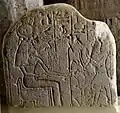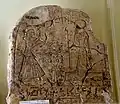Was-sceptre
The was (Egyptian wꜣs "power, dominion"[1]) sceptre is a symbol that appeared often in relics, art, and hieroglyphs associated with the ancient Egyptian religion. It appears as a stylized animal head at the top of a long, straight staff with a forked end.

| w3s in hieroglyphs | ||
|---|---|---|
Was sceptres were used as symbols of power or dominion, and were associated with ancient Egyptian deities such as Set or Anubis[2] as well as with the pharaoh. Was sceptres also represent the Set animal or Khnum. In later use, it was a symbol of control over the force of chaos that Set represented.
In a funerary context the was sceptre was responsible for the well-being of the deceased, and was thus sometimes included in the tomb-equipment or in the decoration of the tomb or coffin. The sceptre is also considered an amulet. The Egyptians perceived the sky as being supported on four pillars, which could have the shape of the was. This sceptre was also the symbol of the fourth Upper Egyptian nome, the nome of Thebes (called wꜣst in Egyptian).[3][1]
Was sceptres were depicted as being carried by gods, pharaohs, and priests. They commonly occur in paintings, drawings, and carvings of gods, and often parallel with emblems such as the ankh and the djed-pillar. Remnants of real was sceptres have been found. They are constructed of faience or wood, where the head and forked tail of the Set animal are visible. The earliest examples date to the First Dynasty.
 Stela showing "Isis the Great Goddess" sitting and holding a was-sceptre. A man, the head of necropolis workers, adores her. Middle Kingdom of Egypt, Petrie Museum of Egyptian Archaeology, London
Stela showing "Isis the Great Goddess" sitting and holding a was-sceptre. A man, the head of necropolis workers, adores her. Middle Kingdom of Egypt, Petrie Museum of Egyptian Archaeology, London A was sceptre carried by the god Set, in the tomb of Thutmose III
A was sceptre carried by the god Set, in the tomb of Thutmose III Upper part of a stela showing a standing man adoring Ra-Horakhty, who holds a was-sceptre. Nineteenth Dynasty of Egypt. Petrie Museum of Egyptian Archaeology, London
Upper part of a stela showing a standing man adoring Ra-Horakhty, who holds a was-sceptre. Nineteenth Dynasty of Egypt. Petrie Museum of Egyptian Archaeology, London.jpg.webp) Head of a physical was sceptre made from faience
Head of a physical was sceptre made from faience was-shaped amulet with animal head and forked tail
was-shaped amulet with animal head and forked tail
The Was (wꜣs) is the Egyptian hieroglyph character representing power.
See also
References
- Allen, James P. (2014-07-24). Middle Egyptian: An Introduction to the Language and Culture of Hieroglyphs. Cambridge University Press. p. 579. ISBN 9781139917094.
- "Horemheb KV 57". osirisnet.net. Retrieved 2012-07-23.
- "Was–sceptre". GlobalEgyptianMuseum.org. Retrieved 2012-07-23.
